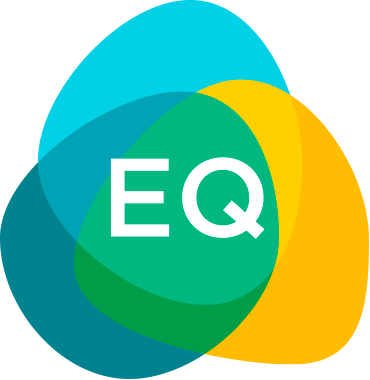
The EQ IQ series
Equity Quotient for real estate: From property to portfolio
How Equity Quotient’s rich data and analytics platform can help real estate leaders capitalize on socioeconomic data and insights to unlock growth.

The EQ IQ series
Equity Quotient for real estate: From property to portfolio
How Equity Quotient’s rich data and analytics platform can help real estate leaders capitalize on their ESG S-factor social impact to unlock growth.
Equity Quotient for real estate: Summary challenge, solution and output
Equity Quotient is a stakeholder intelligence and impact measurement platform that helps organizations shape sustainable growth, manage risk, and automate compliance. The real estate industry stands to benefit from EQ through three key use cases:
- Regulatory reporting
- Strategic planning
- Execution success
1. Compliance reporting
Real estate challenges:
- Investment fundraising
- Project development approvals
- Sustainable property success
Equity Quotient solution:
- Stakeholder alignment: Employees and service providers, supply chain, tenants and customers, and the community at large
- Community investment and socioeconomic impact: Regional spend with demographic, social impact or S-factor lens
- Social impact benchmarking and trending: Micro-segment demographics as boundary condition
Equity Quotient outputs:
- Dashboard views by stakeholder or function
- Export content for external systems and third-party reports and surveys
- Automated reports based on third-party templates
2. Strategic planning
Real estate challenge:
- Business performance compared to a region’s economic performance
- Performance impact indicators (e.g. S-factor alignment vs. financial results)
- Social KPIs and cost/benefit analytics across all strategy initiatives
Equity Quotient solution:
- Dashboard discovery and root cause analysis: Financial performance vs. stakeholder dynamics (e.g. S-factor alignment vs. community)
- Brainstorming with “what if” trade-offs: Untapped opportunities and cost vs. benefit of pursuing
- Performance tracking and operational agility: Corporate goals cascading to micro-region, dynamic tracking across levels from property to portfolio
Equity Quotient outputs:
- Dashboard views by stakeholder or function for pre-planning and research
- Export content for functional presentations, performance reviews and proposed initiatives for the next fiscal year
- Goal-setting and automated tracking across functions
3. Execution success
Real estate challenge:
- Reliable, cost-effective supplier and service provider ecosystem
- Effective marketing engine relevant to property or region micro-segment
- Disconnect between strategic goals and reporting with local execution
Equity Quotient solution:
- Regional supply chain and service provider ecosystem: Visibility into the current procurement landscape vs. possible providers to widen the aperture of opportunity and impact
- Micro-segment marketing analytics: Detailed understanding of each property’s community to devise campaign tactics that are relevant, impactful and achieve stronger ROI
- Granular, relevant peer benchmarking and impact analytics: Continuously see stakeholder dynamics in a micro-region and where the business is succeeding, improving or requires adjustment and how that plays into the broader portfolio
Equity Quotient outputs:
- Dashboard views tailored by function and location to drive execution success
- Enterprise system monitoring–integration for AI monitoring and stakeholder impact risk management
- Automated reports for operational cadence with management
Equity Quotient for real estate: Detailed overview of challenge, solution and output
1. Compliance reporting
Industry challenge
All organizations require some level of regulatory reporting, either for boards and investors, state, local or federal government entities or other community or industry associations. The call for greater accountability and transparency have created the mandate for objective, concrete metrics around impact, both from an environmental and social perspective—so increasingly, this reporting is focused on ESG or socioeconomic impact data.
To date, the E-factor, or environmental impact, has been the focus of ESG and impact reporting. Dozens of firms have emerged to help real estate developers measure and manage their green initiatives and impact to drive improvement in emissions and business results. The results of these initiatives have taken the form of cost savings, investor and fundraising success and positive market-facing outcomes through tenant traction, positive community engagement and expediting local permit approvals.
While most real estate firms—particularly investment funds, developers and property managers—believe they understand their E-factor and have it well in hand with a continuum of clear guidelines, suppliers and service providers and systems and reporting, nearly all firms feel out of control when it comes to the S-factor or socioeconomic impact. Understanding what the S-factor means to them and devising an approach that’s actionable and achievable is a challenge that hasn’t been solved—yet feedback from the real estate ecosystem indicates it is ready and eager to figure out the intersection between performance and impact.
There are three reasons why:
- Investment fundraising: The need for measuring and managing the S-factor has emerged within the fundraising process. Investor limited partners (LPs) are demanding clarity on past social impact performance and plans for future impact based on reasonable projections as part of their investment scoring models that weight the S-factor at greater than 50% of their calculations.
- Project development approvals: Meanwhile, developers must have their S-factor in order to realize success with their projects (e.g. commercial/retail, multi-family residential). This is necessary to seek approvals required by state and local authorities and the community organizations that reside in the locations in which these projects will be built. Without a clear, compelling set of metrics around social impact, particularly a commitment to equity and ultimately demonstrable community investment and impact, developers risk never getting projects off the ground or facing barriers and complexity that lengthen development cycles and increase costs.
- Sustainable property success: The long-term viability of projects, particularly multi-family residential and commercial projects such as retail malls and apartment complexes, requires a rich understanding of socioeconomic data and insights to effectively engage the community and maintain a strong brand that attracts consumers over the long-term. Measuring social impact on a dynamic basis to understand where a property might be misaligned with its community from a tenant or supplier standpoint is key to driving that success. Having a finger on the pulse of the S-factor and related metrics provides important data that can be shown to the community to build trust, engagement and financial success.
While the real estate industry initially hoped ESG would be a fad and the term has become increasingly controversial, leaders have come to realize that reporting on the environmental and social impact of the industry in a way that is concrete and transparent is here to stay. Meanwhile, the real estate funds and development firms that decided to embrace reporting early now find themselves with significant competitive advantage, particularly on the investor fundraising and project approval side of their business. This realization has intensified pressure on the real estate firms that rejected the movement and now struggle to play catch up. These firms now find themselves at risk of being irrelevant—or even worse, out of business.
Equity Quotient solution
With Equity Quotient, real estate investment funds, developers and property managers can automatically generate analytics and reporting to help drive success with fundraising, project approvals with state and local entities and property-operating success over the longer-term. With EQ’s rich data platform powered by detailed demographic data, real estate firms can define the relevant region at the most granular levels and immediately understand the following:
- Stakeholder alignment: How real estate developers’ stakeholder portfolios, particularly their employees, broader ecosystem of service providers and their commercial or residential tenants, compare to the communities where they operate from a demographic standpoint. This comparison can help provide concrete, objective information for evaluating entities around what is possible in terms of community demographics, or the relevant “denominator” for diversity, equity and inclusion, compared to what the real estate firm has achieved thus far.
- Community investment and economic impact: Additionally, EQ provides the ability to quickly calculate investment impact on relevant communities in terms of spend on local service providers and other related expenses, profiled in terms of demographics . Demographics here refers to spending on minority and women owned businesses that are electricians, plumbers, painters, roofters, landscapers and cleaning services, among others. This view of investment or economic impact in a micro-region derived from that data can provide important information about how a real estate developer is playing a vital role in the economic health of a region and being intentional about their impact and the markets where they operate and generate investment returns. It can also concretely compare the actual allocation of investment in minority- and women-owned businesses (MWOB) by micro-vertical compared to the available MWOB businesses in the relevant micro-region.
- Social impact benchmarking and trending: Real estate firms are able to establish clear, concrete and achievable objectives that can be provided to relevant stakeholders on both the investor and community or market side of the equation. Equity Quotient’s system makes it possible to automatically derive a view of how the firm is tracking to its goals and the broader community, driving automated visibility and achieving strategic alignment for executive teams, their boards and the company. As Equity Quotient’s data platform grows, the solution will also make it possible to benchmark progress against industry peers in an anonymized way as well as the community more broadly.
These three key forms of analytics can be published for various audience presentations and standard reporting required of real estate funds, developers and property management firms through the following options:
- Dashboard views: Dynamic visualizations enable boards, managers and their teams to explore the data elements needed for the continuum of reporting for various stakeholder groups and compliance mandates.
- Export content: EQ outputs, including data, metrics and visualizations, can be exported for use in internal systems or incorporated into presentations or reports being developed internally (e.g. SEC 10-Ks, 10-Qs, impact/ ESG surveys and annual reports).
- Automated reports: Companies can create templates within the Equity Quotient system that are dynamically populated with relevant values on demand or at scheduled intervals. These online reports can be easily shared with or submitted to relevant entities or exported as PDFs that can be emailed or distributed through other methods.
2. Strategic planning
Industry challenge
All real estate organizations embark on a strategic planning process that requires internal and external data to understand the market landscape and opportunity it presents, combined with internal data on past business initiatives and their performance. That process is typically periodic, yet ongoing and dynamic. For example, there might be a point-in-time effort annually to take a step back and determine the best way forward and establish concrete goals and metrics. Teams also require the ability to continually revisit planned vs. actual performance, adjusting goals and initiatives designed to achieve them as more is learned and experienced related to challenges and opportunities.
With real estate investment funds, development companies and property management firms, the key to getting this right is understanding the demographic, or social and economic, landscape of the markets in which they are currently operating as well as the prospective micro-regions they might target for new growth opportunities. This analysis requires the need to understand the populations in a given region—particularly attributes such as race, level of education, income and veterans status, as well as public health metrics and data on the business landscape from both an economic and demographic perspective.
The challenge with strategic planning is that the skills, cost and complexity required to gather all of the relevant data in a way that’s consumable and actionable is often a daunting task for real estate developers. Most developers operate with relatively small or lean teams despite relatively large financial and social impact footprints. Data is the lifeblood of success for the full continuum of real estate firms, so gaining access to the full picture of data for the markets where they operate in a way that’s automated and trusted is the key to success.
Equity Quotient solution
With Equity Quotient, real estate firms have the ability to quickly see market opportunity and devise strategic imperatives for their business. Views of market demographics over time, including the evolution of both end consumer dynamics as well as the business landscape, provides firms with a picture of the socioeconomic landscape that underpins the markets in which they are already operating. This helps them better anticipate challenges and opportunities with their existing investments while also uncovering views to new markets they might consider pursuing.
By intersecting company stakeholder demographic and financial performance data with EQ’s rich data platform powered by detailed demographic, health, education and economic data, real estate firms are able to quickly “see the board” on their relevant regions at the most granular levels and immediately understand the following:
- Business performance vs. region performance: How a real estate fund, development firm or property management company is performing from a financial performance and growth standpoint compared to their focus regions. More specifically, is their performance tracking or aligning to the region’s economic movements, or is there a disconnect that requires analysis and action?
- Performance impact indicators: Real estate firms are able to explore the “why” behind their performance and brainstorm for the future in a way that is more efficient and effective than current approaches. Example questions they are able to explore with EQ’s system include:
- Are there disconnects between the real estate company’s operations and the socioeconomic climate in a given micro-region that might explain anomalous disconnects between the firm’s performance, for better or worse?
- Are there specific actions or initiatives the firm might take to drive stronger financial success through better alignment between stakeholders in their ecosystem and the communities or markets where they operate–for example, new approaches to their supplier ecosystem and procurement processes, or fresh marketing approaches to engage and retain tenants?
- Do trends emerge in the region’s socioeconomic landscape that uncover opportunities for growth through adjustments in current strategy or execution or perhaps entirely new investment initiatives?
- Strategic initiatives and impact measurement: As an extension of this performance exploration in the context of the communities or markets where they operate, real estate firms are able to establish their go-forward objectives for growth in a way that is clear and concrete. Establishing “From:→To:” metrics within the platform enables real estate firms to create a shared view of where they currently stand and what they want to achieve, and then align around the initiatives they’re going to pursue to realize success. The platform gives teams the ability to continuously see their progress against goals, as well as the reasons behind performance based on socioeconomic dynamics in the micro-markets where they operate. This enables them to quickly and continuously monitor challenges and opportunities related to their strategic imperatives and adjustments in their initiatives or execution approaches.
Increasingly, real estate investment funds, development firms, and property managers are realizing that clarity, transparency and alignment are foundational to driving success. Equity Quotient’s data-driven platform is focused on providing insights and fostering collaboration with the goal of helping firms achieve that dynamic in their business, both at a micro-level within teams and a more macro-level across functions and even the partnership continuum that can often span the supply chain—from investor to developer to manager. EQ supports that ongoing strategic collaboration through the following functionality:
- Dashboard discovery and root cause analysis: Dynamic visualizations enable teams to explore the data elements needed for strategic planning, particularly to understand past and present performance and the relevant variables contributing to that performance at a micro-region level in the markets or communities in which they operate. After seeing their performance compared to the communities or markets in which they operate, EQ lets real estate leaders immediately see where risks or opportunities might exist and the actions they might take to mitigate or capitalize on them. For example, they might see an opportunity to evolve their procurement strategies to achieve tighter alignment with local service providers and ultimately drive stronger social impact metrics and business performance.
- Brainstorming and “what if” tradeoffs: Firms are always managing a myriad of strategic decisions and the cost-benefit of each. These decisions typically involve a combination of stakeholders, particularly their employees and suppliers or service providers, as well as their tenants and broader customer base engaged in their properties and also the broader communities where they operate. EQ Opportunity Index dashboards make it possible for companies to more quickly and effectively calculate the cost-benefit of strategic initiatives, make tradeoffs that are always challenging and controversial but important, establish clear goals or metrics expected of each investment initiative, and track actual vs. expected results.
- Performance tracking and operational agility: Strategic planning is an exercise in futility unless executive teams can achieve a model that makes those point-in-time decisions core to daily operations and shared across all relevant stakeholders. EQ Opportunity Index dashboards enable executive teams to establish and share key metrics and keep those goals top of mind throughout the organization, making it possible for each function to gain their unique view of the data and how their actions contribute to success as part of the broader team. EQ also helps teams come together early and often with a shared view of planned vs. actual performance and insights into what’s driving performance positively or negatively while teeing up conversations on actions they might take to adjust objectives or the initiatives or investments being made to achieve those goals.
3. Execution success
Industry challenge
Once strategic goals have been put in place, it’s time to dive into the details to execute against them effectively and maximize the return on investment that has been allocated to each of them. For real estate investment funds, developers and property managers, execution takes many forms. For some in the organization dedicated to internal operations, it might be focused on achieving a productive, reliable service provider ecosystem and supply chain that keep properties in good shape and contribute to property valuation growth objectives over time. For other more externally facing members of the organization, it might be dedicated to marketing initiatives that will maximize rents and other revenue sources, or customer and community engagement that minimizes vacancies, attrition and related dynamics that can compromise cashflow or dampen performance success.
Equity Quotient solution
With Equity Quotient, real estate firms have the ability to execute stakeholder-related initiatives and target investments more effectively. On the employee and supplier side, real estate firms are able to tap into a view of the business landscape by micro-vertical in each community to widen in the aperture of resources available to drive success. Being more open about the service provider and supplier ecosystem that’s available to them as part of a disciplined procurement process can make it possible to uncover expanded sources, lower costs and decrease the risk of disruption. Meanwhile, on the marketing and customer engagement side, EQ Opportunity Index dashboards enable real estate leaders to gain a more granular and insightful view of the communities in which they operate, both from an end consumer and local business standpoint. Better understanding the demographics of a region and devising approaches that capitalize on latent, untapped opportunities with more relevant initiatives that align to those communities can unlock new levels of growth.
Equity Quotient intersects company stakeholder demographic and financial performance data with a rich data platform powered by detailed demographic, health, education and economic data to help real estate execution teams achieve the following outcomes:
- Regional supply chain and service provider ecosystem visibility: By powering teams with stronger data on the communities in which they operate, EQ helps real estate procurement managers achieve stronger supply chains. Through cultivating a more open view of the service provider ecosystem in each region by micro-vertical, real estate firms are able to achieve a more open approach to building a service provider ecosystem that can ultimately drive stronger operational resilience, higher quality service and other outcomes and cut down costs.
- Micro-segment marketing analytics and feedback loop: Each micro-market in which real estate firms operate is unique from a social, economic and political standpoint. Effectively engaging those micro-markets requires a deep, thoughtful understanding of local dynamics to devise effective campaigns that maximize tenancy, rents and retention. EQ’s rich data platform powered by local intelligence on population demographics, the business landscape and other social metrics based on education and health can help real estate leaders target their micro-regions in more relevant, effective ways. This can yield a stronger return on marketing spend, bolster retention and achieve a portfolio of tenants that will maximize rent revenue and long-term property values.
- Granular, relevant peer benchmarking and impact analytics: Core to understanding performance is being able to see how you compare to relevant peers. As Equity Quotient’s platform achieves critical mass engagement from real estate firms, customers will be able to access rich comps on a variety of metrics to help hone execution strategies on both the cost and revenue side of the business. EQ Opportunity Index dashboards are focused on supporting decision makers at the most granular levels needed to drive actionable insights and ultimately gain competitive advantage. Additionally, granular analytics by property vs. micro-segment enables real estate firms to continuously understand how they’re performing at the most granular levels, and how that feeds into their broader impact posture across multiple properties and regions.
Conclusion
The pressure on real estate firms to achieve strong performance while also driving positive impact has never been greater. Understanding impact related to the socioeconomic landscape has become challenging for companies due to the cost and complexity of gathering data and assembling it into actionable insights and automated reporting for various stakeholders. However, there’s unprecedented opportunity in embracing the advanced analytics that are available to firms that are willing to embrace the challenge and turn it into a competitive advantage.
Companies that proactively make the intersection of impact and performance core to their strategic planning and operational DNA outperform their peers on every major KPI, both internally in terms of top-line growth and profitability and externally in terms of market value and cost of capital. Now is the time to gain unprecedented insight into your current performance and impact and discover untapped opportunities for growth. Equity Quotient can help companies uncover that “alpha” competitive advantage while reducing the cost of reporting and aligning the entire organization and broader ecosystem around a clear, compelling journey to growth.




